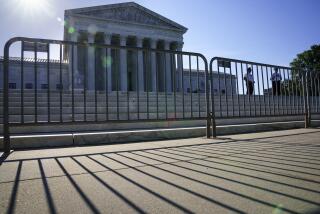THE JUDICIARY : Changing Faces, Changing Benchmarks
- Share via
WASHINGTON — The Supreme Court term that is expected to end Thursday has seen the emergence of new personalities on the bench and the transformation of a few veterans. Here is a look at some key figures during the ‘94-95 term.
Professor Breyer: The newest member of the court, Stephen G. Breyer, hardly acted like the quiet rookie. From his first day, Breyer beamed with confidence. He often took it upon himself to summarize an hourlong argument, sounding as though no one at that moment had it quite right.
In January he delivered his first opinion, but unlike other justices, he did not read from the text. Instead, the former Harvard law professor looked out to the audience and gave a folksy account of the case. It concerned an Alabama couple who wanted to sue a termite inspector who failed to spot the insects eating away at their house. Their contract called for arbitration.
“So, on the one hand, you have a state policy that allows someone who has been injured to go to court,” said Breyer, 56. “On the other hand, you have a federal law that says contracts with arbitration clauses must be enforced.”
“We think Terminix [the company] has the better argument,” he concluded, explaining the reasoning of the decision.
Looking supremely satisfied, he smiled and sat back in his chair, only to have Justice Clarence Thomas lean over and whisper that the opinion was not unanimous.
“Oh, yes, there is a dissent. How could I have forgotten!” Breyer exclaimed, noting for the record that Justices Thomas and Antonin Scalia had filed dissents.
Yankee Accent: Justice David H. Souter, the gentlemanly judge from New Hampshire, sometimes asks long and abstract questions that leave the attorneys perplexed. Other times, it’s his New England accent that confuses them.
During the argument over affirmative action, Souter, 55, asked the counsel for a road builder whether his “complaint specified the presumption as being the floor in the statutory scheme?”
The lawyer paused and looked down. “Excuse me, your honor, the floor ?”
No, said Souter smiling, making clear that “in my regional accent” the word that sounds like floor is spelled flaw .
Talkative Thomas: Clarence Thomas spent three silent years on the bench and still speaks rarely. But on at least three occasions this year, he spoke up. And with a deep, strong voice, he makes his points heard.
During arguments in an Ohio case that challenged whether a religious symbol can be placed in front of a state office building, Thomas, 47, disputed the premise that a cross planted by a Ku Klux Klan leader was a religious symbol.
“What does a burning cross symbolize?” Thomas asked. “If I said that a member of the Ku Klux Klan is carrying a cross down Pennsylvania Avenue, would the average person think the klan is engaged in an exercise of religion or a political statement?”
Ol’ Man River: Chief Justice William H. Rehnquist did his part to brighten up the bench by having four gold stripes sewn onto the sleeves of his black robe. He had copied the idea from a costume worn by the Lord Chancellor in a local Gilbert and Sullivan production, he said.
Rehnquist, 70, has vast knowledge on all sorts of subjects and regularly stumps his clerks in trivia contests. He also delights in cases that other justices avoid, such as boundary and water disputes.
Last month, he delivered an opinion in the case of Kansas vs. Colorado and took the opportunity to teach a lesson on the history and geography of the Arkansas River.
“The Arkansas River rises on the east side of the Continental Divide, between Climax and Leadville, Colo.,” he began. He followed its course for 1,450 miles before it flows into the Mississippi River and recounted the journeys of river explorers Francisco Coronado, Hernando De Soto and Zebulon Pike.
A notoriously fast worker, the chief justice informed his slow-moving colleagues several weeks ago that he had booked a flight to London for Thursday evening, June 29, where he will teach at Cambridge University.
“Lawyers need a deadline,” he mused, threatening to leave even if the opinions were not finished. But sure enough, Rehnquist announced Monday that the final opinions for the term are expected to be announced Thursday morning.
Loyal Opposition: Twenty years ago, a moderate Republican judge from Chicago, John Paul Stevens, was chosen to replace the fiery liberal William O. Douglas. And as predicted, he cast the fifth vote to restore the death penalty. But since then, as the court has moved right, Stevens has moved left. And this year, he emerged as its senior liberal and leader of the loyal opposition. When the chief justice fails to win a majority for his conservative stands, Stevens, 75, controls the outcome. He delivered the court’s opinion striking down term limits, but sounded off in dissent in the case that restricted federal affirmative action programs. He had strongly opposed government affirmative action in the 1970s.
This week, Stevens joked that his colleagues should take their time finishing their opinions. By Friday morning, if the work is not done, he becomes acting chief justice.
More to Read
Get the L.A. Times Politics newsletter
Deeply reported insights into legislation, politics and policy from Sacramento, Washington and beyond. In your inbox twice per week.
You may occasionally receive promotional content from the Los Angeles Times.











